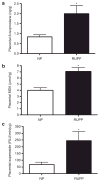Role of reactive oxygen species in hypertension produced by reduced uterine perfusion in pregnant rats
- PMID: 18670418
- PMCID: PMC2786058
- DOI: 10.1038/ajh.2008.239
Role of reactive oxygen species in hypertension produced by reduced uterine perfusion in pregnant rats
Abstract
Background: Although recent studies indicate preeclampsia (PE) is associated with increased oxidative stress, the role of reactive oxygen species in the hypertension associated with PE remains unclear. We sought to test the hypothesis that placental ischemia increases oxidative stress which in turn, contributes to hypertension.
Methods: Reduction in uterine perfusion pressure (RUPP) was induced by placing silver clips on the abdominal aorta and the ovarian arteries on day 14 of pregnancy. On day 20 of pregnancy, mean arterial pressure (MAP) was measured and oxidative stress was assessed in renal and placental tissues whereas systemic administration of tempol, a superoxide dismutase (SOD) mimetic, was used to evaluate the contribution of reactive oxygen species on RUPP-induced hypertension.
Results: MAP (120 +/- 2 mm Hg vs.106 +/- 3 mm Hg), placental levels of 8-isoprostane (1.9 +/- 0.4 ng/g tissue vs. 0.8 +/- 0.1 ng/g tissue), and malondialdehyde (MDA) (6.9 +/- 0.6 micromol/g tissue vs. 3.9 +/- 0.4 micromol/g tissue) were increased, whereas renal cortical SOD activity was decreased in RUPP rats (1.2 +/- 0.1 units/mg protein vs. 1.6 +/- 0.1 units/mg protein) at day 20 of gestation (20 dG) compared to controls. Chronic treatment with tempol attenuated the hypertension (RUPP + tempol 112 +/- 2 mm Hg vs. RUPP, 120 +/- 2 mm Hg) associated with RUPP, whereas tempol had no effect on MAP (NP, 106 +/- 3 vs. NP + tempol, 108 +/- 2) in control rats.
Conclusion: The results of this study indicate that placental ischemia decreases innate antioxidant activity resulting in elevated oxidative stress which appears to play a role in mediating hypertension associated with chronic RUPP in pregnant rats.
Conflict of interest statement
Disclosure: The authors declared no conflict of interest.
Figures


References
-
- Sibai B, Dekker G, Kupferminc M. Pre-eclampsia. Lancet. 2005;365:785–799. - PubMed
-
- Roberts JM, Pearson G, Cutler J, Lindheimer M NHLBI Working Group on Research on Hypertension During Pregnancy. Summary of the NHLBI Working Group on Research on Hypertension During Pregnancy. Hypertension. 2003;41:437–445. - PubMed
-
- Gilbert JS, Ryan MJ, La Marca BB, Sedeek MH, Murphy SR, Granger JP. Pathophysiology of hypertension during preeclampsia: linking placental ischemia with endothelial dysfunction. Am J Physiol Heart Circ Physiol. 2008;294:H541–H550. - PubMed
-
- Touyz RM. Reactive oxygen species, vascular oxidative stress, and redox signaling in hypertension: what is the clinical significance? Hypertension. 2004;44:248–252. - PubMed
-
- Roberts JM, Hubel CA. Is oxidative stress the link in the two-stage model of pre-eclampsia? Lancet. 1999;354:788–789. - PubMed
Publication types
MeSH terms
Substances
Grants and funding
LinkOut - more resources
Full Text Sources
Medical
Miscellaneous

